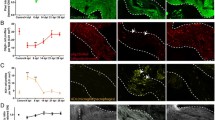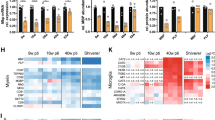Abstract
To study cellular and molecular mechanisms of demyelination and remyelination in vivo, we developed a transgenic zebrafish line, Tg(mbp:mCherry-NTR), in which expression of the bacterial enzyme nitroreductase (NTR) is driven under the myelin basic protein promoter (mbp) and thus is expressed in myelinating glia. When NTR-expressing larvae are treated with the prodrug metronidazole, the reaction between NTR and Mtz results in a toxic metabolite which selectively kills NTR-expressing cells. Using the Tg(mbp:mCherry-NTR) line, we can ablate two-thirds of oligodendrocytes following a 2-day MTZ treatment. Demyelination is evident seven days later, and remyelination is observed 16 days after Mtz treatment. The Tg(mbp:mCherry-NTR) model can be used to image cell behavior during, and to test how genetic manipulations or chemical compounds regulate, demyelination and remyelination. In this chapter, we describe the methods we used to characterize the oligodendrocyte loss, demyelination and remyelination in the Tg(mbp:mCherry-NTR) model.
Access this chapter
Tax calculation will be finalised at checkout
Purchases are for personal use only
Similar content being viewed by others
References
Nave K-A, Werner HB (2014) Myelination of the nervous system: mechanisms and functions. Annu Rev Cell Dev Biol 30:503–533. https://doi.org/10.1146/annurev-cellbio-100913-013101
Boespflug-Tanguy O, Labauge P, Fogli A, Vaurs-Barriere C (2008) Genes involved in leukodystrophies: a glance at glial functions. Curr Neurol Neurosci Rep 8:217–229
Pacey LKK, Xuan ICY, Guan S et al (2013) Delayed myelination in a mouse model of fragile X syndrome. Hum Mol Genet 22:3920–3930. https://doi.org/10.1093/hmg/ddt246
Hercher C, Chopra V, Beasley CL (2014) Evidence for morphological alterations in prefrontal white matter glia in schizophrenia and bipolar disorder. J Psychiatry Neurosci 39:376–385
Windrem MS, Osipovitch M, Liu Z et al (2017) Human iPSC glial mouse chimeras reveal glial contributions to schizophrenia. Cell Stem Cell 21:195–208.e6. https://doi.org/10.1016/j.stem.2017.06.012
Kang SH, Li Y, Fukaya M et al (2013) Degeneration and impaired regeneration of gray matter oligodendrocytes in amyotrophic lateral sclerosis. Nat Neurosci 16:571–579. https://doi.org/10.1038/nn.3357
Thompson AJ, Baranzini SE, Geurts J et al (2018) Multiple sclerosis. Lancet 391:1622–1636. https://doi.org/10.1016/S0140-6736(18)30481-1
Franklin RJM, Ffrench-Constant C (2017) Regenerating CNS myelin—from mechanisms to experimental medicines. Nat Rev Neurosci 18:753–769. https://doi.org/10.1038/nrn.2017.136
Kornek B, Storch MK, Weissert R et al (2010) Multiple sclerosis and chronic autoimmune encephalomyelitis. Am J Pathol 157:267–276. https://doi.org/10.1016/S0002-9440(10)64537-3
Patrikios P, Stadelmann C, Kutzelnigg A et al (2006) Remyelination is extensive in a subset of multiple sclerosis patients. Brain 129:3165–3172. https://doi.org/10.1093/brain/awl217
Smith KJ, Blakemore WF, McDonald WI (1981) The restoration of conduction by central remyelination. Brain 104:383–404
Jeffery ND, Blakemore WF (1997) Locomotor deficits induced by experimental spinal cord demyelination are abolished by spontaneous remyelination. Brain 120:27–37. https://doi.org/10.1093/brain/120.1.27
Irvine KA, Blakemore WF (2008) Remyelination protects axons from demyelination-associated axon degeneration. Brain 131:1464–1477. https://doi.org/10.1093/brain/awn080
Mei F, Lehmann-Horn K, Shen Y-AA et al (2016) Accelerated remyelination during inflammatory demyelination prevents axonal loss and improves functional recovery. Elife 5:e18246. https://doi.org/10.7554/eLife.18246
Cole KLH, Early JJ, Lyons DA (2017) Drug discovery for remyelination and treatment of MS. Glia 65:1565–1589. https://doi.org/10.1002/glia.23166
Traka M, Arasi K, Avila RL et al (2010) A genetic mouse model of adult-onset, pervasive central nervous system demyelination with robust remyelination. Brain 133:3017–3029. https://doi.org/10.1093/brain/awq247
Traka M, Podojil JR, McCarthy DP et al (2015) Oligodendrocyte death results in immune-mediated CNS demyelination. Nat Neurosci 19:65–74. https://doi.org/10.1038/nn.4193
Pohl HBF, Porcheri C, Mueggler T et al (2011) Genetically induced adult oligodendrocyte cell death is associated with poor myelin clearance, reduced remyelination, and axonal damage. J Neurosci 31:1069–1080. https://doi.org/10.1523/JNEUROSCI.5035-10.2011
Locatelli G, Wörtge S, Buch T et al (2012) Primary oligodendrocyte death does not elicit anti-CNS immunity. Nat Neurosci 15:543–550. https://doi.org/10.1038/nn.3062
Kaya F, Mannioui A, Chesneau A et al (2012) Live imaging of targeted cell ablation in Xenopus: a new model to study demyelination and repair. J Neurosci 32:12885–12895. https://doi.org/10.1523/JNEUROSCI.2252-12.2012
Almeida RG, Czopka T, ffrench-Constant C, Lyons DA (2011) Individual axons regulate the myelinating potential of single oligodendrocytes in vivo. Development 138:4443–4450. https://doi.org/10.1242/dev.071001
MacRae CA, Peterson RT (2015) Zebrafish as tools for drug discovery. Nat Rev Drug Discov 14:721–731. https://doi.org/10.1038/nrd4627
Early JJ, Cole KL, Williamson JM et al (2018) An automated high-resolution in vivo screen in zebrafish to identify chemical regulators of myelination. Elife 7:4443. https://doi.org/10.7554/eLife.35136
Pisharath H, Parsons MJ (2009) Nitroreductase-mediated cell ablation in transgenic zebrafish embryos. Methods Mol Biol (Clifton, NJ) 546:133–143. https://doi.org/10.1007/978-1-60327-977-2_9
Curado S, Anderson RM, Jungblut B et al (2007) Conditional targeted cell ablation in zebrafish: a new tool for regeneration studies. Dev Dyn 236:1025–1035. https://doi.org/10.1002/dvdy.21100
Karttunen MJ, Czopka T, Goedhart M et al (2017) Regeneration of myelin sheaths of normal length and thickness in the zebrafish CNS correlates with growth of axons in caliber. PLoS One 12:e0178058. https://doi.org/10.1371/journal.pone.0178058
Author information
Authors and Affiliations
Corresponding author
Editor information
Editors and Affiliations
Rights and permissions
Copyright information
© 2019 Springer Science+Business Media, LLC, part of Springer Nature
About this protocol
Cite this protocol
Karttunen, M.J., Lyons, D.A. (2019). A Drug-Inducible Transgenic Zebrafish Model for Myelinating Glial Cell Ablation. In: Lyons, D., Kegel, L. (eds) Oligodendrocytes. Methods in Molecular Biology, vol 1936. Humana Press, New York, NY. https://doi.org/10.1007/978-1-4939-9072-6_13
Download citation
DOI: https://doi.org/10.1007/978-1-4939-9072-6_13
Published:
Publisher Name: Humana Press, New York, NY
Print ISBN: 978-1-4939-9070-2
Online ISBN: 978-1-4939-9072-6
eBook Packages: Springer Protocols




